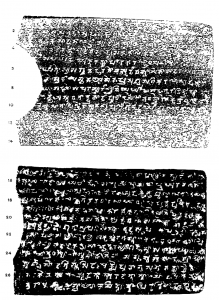
Seal.
[The seal] of the government of a district in the province of Vâraka.
Plate.
Welfare. During the sovereignty of the supreme king of great kings, Srî-Dharmâditya the Emperor, which sovereignty is without adversary on this earth, and is equal in steadfastness to Nṛga, Nahuṣa, Yayâti and Ambariṣa ―in the time of the reigning of the Uparika Nâgadeva, chief warden of the gate, in New Avakâsikâ, who (Nâgadeva) gained his dignity through gratifying that Dharmâditya, Gopâla-svâmin is the customs-officer, appointed as such in-chief in this district within the province of Vâraka by this very (Nâgadeva). Whereas, while he (Gopâla-svâmin) is administering affairs, Vasudeva-svâmin respectfully approached and apprised both the district government, wherein the oldest kâyastha Nayasena is the chief, and also the leading men of the districts, foremost of whom is the leading man Somaghoṣa, thus:―”I would wish through your honours’ favour to buy at the proper price from your honours cultivated lands with portions; and, in order to augment the merit of my mother and father and mine own merit, bestow it on the virtuous brahman Somasvâmin, who is of the lineage of Kaṇva, is a Vâjasaneya and is a Lauhitya: therefore do ye deign in compliance with my intimation to server off a portion of land ………………………..”
Wherefore we, giving heed to this very request, have―because there is a rule established regarding things transacted in the eastern region, namely, that sultivated lands are sold at the rate of the sum of four dînâras for the area which can be sown with a kulya of seed ―taken from this Vasu-svâmin a couple of dînâras for [so many] kulya-sowing areas of waste land plus a pravartta sowing area, and have according to the value …………………………………………………. and have determined by the record-keeper Janmabhûti’s determination …………….. the compact portions of cultivated land belonging to the leading man Thoḍa …………………… and have yesterday (?) severed the lands off according to the standard measure of eight reeds in breadth and nine reeds in length by the hand of trusty and upright Sivacandra ………………….. and have sold them to the brahman Vasudeva. He has bought them.
And the boundary-indications are here stated: on the east, the boundary of Soga’s (?) copper-plate land; [on the south] the boundary marked by the old-standing paṭṭuki and parkaṭî trees; on the west the boundary marked by the bullock-cart track ………………………………….. and the ship’s mast, on the north, the boundary of Garga-svâmin’s copper-plate land.
And here apply the verses of the Dharma-śâstra. The grantor of land rejoices sixty thousand years in Svarga: may both he who annuls a grant and he who abets such an act dwell just so many years in hell. Whoever confiscates land that has been granted away by himself or granted away by another, he becoming a worm in a dog’s ordure, rots along with his ancestors.